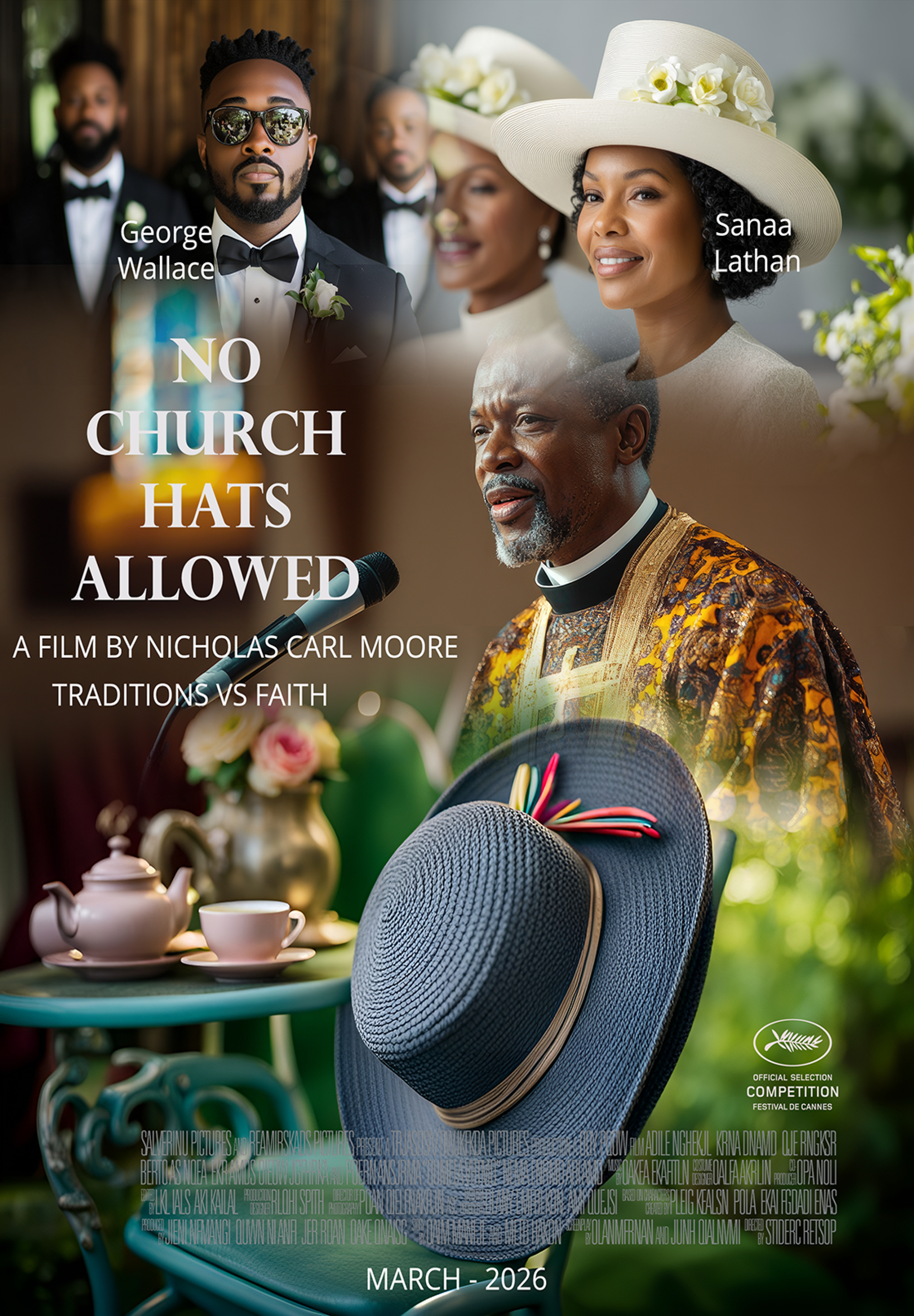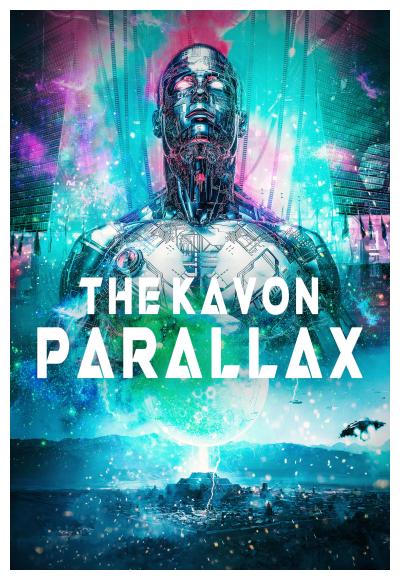
Synopsis/Details
All Accolades & Coverage
SCREENPLAY REVIEW: “NO CHURCH HATS ALLOWED”
**Script Analyst:** [Nolan Filmmaker's Studio]
**Script Title:** *No Church Hats Allowed*
**Date:** [April 30, 2025]
---
## OVERALL STORY STRUCTURE
### Classical Structure & Genre
*No Church Hats Allowed* is an ensemble drama that interweaves romance, family conflict, faith, and a contemporary critique of hypocrisy within the Black church community. The script clearly follows a three-act structure as outlined by screenwriting authorities like Robert McKee (*Story*) and Blake Snyder (*Save the Cat*), with the inciting incident being Nick’s romantic entanglement with Gail and subsequent immersion into church life. The first act establishes Nick’s world, his relationships, and the stakes involved in pursuing Gail—an insider of the tightly knit church community. The second act is driven by Nick’s efforts to assimilate, the unveiling of the church’s secrets, and both internal and external opposition—primarily from Pastor Fairfield and church politics. The climax arrives with the public confrontation and exposure of corruption at the couples’ retreat, leading to the denouement of a reformed, more honest church community.
### Strengths
- **High Stakes:** The personal stakes for Nick (love, belonging, acceptance) are well-balanced with the communal stakes (church integrity, family honor, and the exposure of predators).
- **Multi-Threaded Plot:** Multiple interconnected storylines (Nick & Gail, Regina & Slick Willie, church politics) provide a rich tapestry of conflict and character dynamics.
- **Thematic Resonance:** The script effectively explores themes of hypocrisy, belonging, the search for faith, and the collision of tradition with contemporary values, echoing Truby’s emphasis on moral argument in *The Anatomy of Story*.
### Weaknesses
- **Occasional Overcrowding:** With numerous subplots (e.g., Jonathan’s backstory, Tyrone/Betty, Regina’s arc, church finances), the central romance narrative sometimes struggles for focus, risking a slight dilution of emotional stakes.
- **Resolution Compression:** The final act, while cathartic, feels rushed due to the sheer number of plotlines seeking closure. Some emotional beats (especially between Nick and Gail) could benefit from more room to breathe post-climax.
---
## CHARACTER DEVELOPMENT
### Protagonist: Nick Jones
Nick is a well-crafted protagonist in line with Snyder’s “Save the Cat” principle: he’s charismatic, driven, and flawed, making him relatable and compelling. His arc—from detached restaurateur to engaged, self-reflective community member with a renewed appreciation for faith and family—follows a clear transformation, hitting both internal and external markers of change. His motivation (love for Gail and, gradually, a search for deeper meaning) is believable, and his struggle to fit in is rendered with authenticity and subtle humor.
### Gail Ratliff
Gail is layered and sympathetic—a church “golden child” scarred by past loss and fiercely loyal to tradition and her community. Her resistance to Nick is grounded in real trauma, and her eventual willingness to challenge church dogma shows strong agency. However, at times, her interiority is underplayed, particularly in later acts where she reacts to revelations rather than driving them. Further deepening her perspective during the climax could elevate her role to co-protagonist status.
### Supporting Characters
- **Regina Ratliff:** The “wild child” sister’s subplot is both cautionary and tragic, ultimately dovetailing with the main theme of hypocrisy and secrecy within the church. Her vulnerability and eventual courage (turning in Willie) are well-portrayed.
- **Slick Willie:** Though bordering on caricature in early scenes, his predatory nature is gradually revealed with disturbing realism. He serves as a strong antagonist in the B-plot.
- **Pastor Fairfield:** A nuanced antagonist whose control is rooted in insecurity and institutional power. His complex, paternal relationship with Gail adds depth (though a few moments veer toward melodrama).
- **Momma Ratliff, Jonathan, Tyrone, Jimmy, Betty:** Each secondary character is distinct, providing both comic relief and critical reflection of the core ensemble’s dynamics. The Tyrone/Betty subplot, while humorous, might be trimmed to keep focus on the main narrative.
### Weaknesses
- **Occasional Expository Dialogue:** Some supporting characters (notably Patrick Vaughn and Deacon Harris) are used to dump information, particularly about church finances, rather than revealing it through action or discovery.
- **Villain Complexity:** While Pastor Fairfield is well-drawn, Bishop Mills is a late-arriving, mustache-twirling villain. His motivation is functional but lacks depth.
---
## DIALOGUE QUALITY
### Strengths
- **Authenticity:** The dialogue is rich with African American vernacular and church idioms, capturing the rhythm and humor of the community without resorting to parody.
- **Distinct Voices:** Each character speaks with a unique voice—Nick’s dry wit, Gail’s guarded warmth, Pastor Fairfield’s performative eloquence, and Regina’s youthful bravado.
- **Subtext:** Many scenes, especially between Nick and Gail, or Nick and Pastor Fairfield, simmer with subtext (e.g., the couples’ retreat confrontation), adhering to McKee’s dictum that true drama is what’s unsaid.
### Weaknesses
- **Occasional On-the-Nose Lines:** Emotional revelations (e.g., “You still coming to Sunday dinner?” or “Family doesn’t make you uncomfortable. Family respects boundaries.”) sometimes state the theme too plainly.
- **Monologues:** A few monologues, especially in the third act, could be trimmed or broken up to maintain natural flow.
---
## PACING
### Strengths
- **Dynamic Opening:** The opening scenes (Nick’s restaurant, the Ratliff’s first visit) are brisk, engaging, and quickly establish stakes.
- **Strong Midpoint:** The church service montage and Nick’s first big test as an outsider are compelling and well-paced.
- **Ratcheting Tension:** The script does an excellent job of layering tension—romantic, social, financial, and moral—keeping the audience invested.
### Weaknesses
- **Sagging Second Act:** The proliferation of subplots, especially the extended Betty/Tyrone sequence and repeated church finance discussions, slightly bog down the momentum in the script’s middle (as per Snyder’s “Fun and Games”/“Bad Guys Close In” beats).
- **Climax Density:** The rapid-fire revelations at the retreat risk overwhelming the audience; consider streamlining for clarity and emotional impact.
---
## EMOTIONAL IMPACT
### Strengths
- **Relatability:** The script’s emotional resonance stems from its honest portrayal of loss (Nick’s mother, Gail’s child, Regina’s innocence), the longing for community, and the fear of exclusion—a universal theme made specific by the Black church setting.
- **Moments of Grace:** Scenes such as Gail’s prayer at her altar, Nick’s confession about his mother, and Regina’s confrontation with the truth about Willie are touching without being maudlin.
- **Triumphant Ending:** The denouement, with the church reborn and Nick accepted into both faith and family, is uplifting and cathartic.
### Weaknesses
- **Overt Thematic Statements:** As noted, a few lines deliver the “moral of the story” too explicitly, risking melodrama.
- **Gail’s Agency:** As the story climaxes, Gail is more acted-upon than active; granting her greater agency and clearer emotional choices during the fallout would heighten the impact.
---
## ENGAGEMENT WITH INTENDED AUDIENCE & STORYTELLING TECHNIQUES
### Audience Engagement
*No Church Hats Allowed* is clearly targeted at an audience familiar with Black church culture, intergenerational family dynamics, and the struggle between appearance and authenticity. The script’s humor, cultural specificity, and honest critique of institutional hypocrisy are key draws for both Black and broader audiences.
### Adherence to Screenwriting Principles
- **McKee’s Principles:** The script demonstrates strong understanding of scene design, character desire, and escalating conflict.
- **Snyder’s Save the Cat:** Nick’s “save the cat” moment—agreeing to go to church for Gail, and later exposing corruption—anchors him as a likeable, active protagonist.
- **Truby’s Anatomy of Story:** The story’s “moral argument” (authenticity vs. hypocrisy; family vs. institution) is well-argued through plot and character.
---
## RECOMMENDATIONS
**1. Streamline Subplots:**
Trim some of the supporting characters’ storylines or merge their functions to keep focus on the core ensemble and thematic throughline.
**2. Deepen Emotional Beats, Especially for Gail:**
Give Gail more agency in the third act—allow her to confront her mother and Pastor Fairfield directly, and to articulate her evolving faith and love for Nick.
**3. Tighten Exposition:**
Reveal church financial malfeasance through more organic means (visuals, overheard conversations, or action) rather than expositional dialogue.
**4. Sharpen Climax:**
Spread key revelations over more than one scene or allow for more emotional fallout, rather than a single, overwhelming confrontation.
**5. Update Dialogue for Subtlety:**
Allow more moments to play in subtext; trust the audience to connect the dots about theme and character change.
---
## CONCLUSION
*No Church Hats Allowed* is a lively, heartfelt, and ultimately redemptive script that skillfully interrogates community, faith, and personal integrity. Its greatest strengths are its ensemble cast, authentic voice, and willingness to tackle difficult topics with honesty and humor. With tighter focus and even greater investment in its central romance, it could become not only a crowd-pleaser, but a meaningful contribution to contemporary African American storytelling. Highly promising; recommends for further development and polish.
NO Church Hats COVERAGE SCORE:
Concept: 4/5
The core concept—a successful, rootless Black restaurateur enters a Black megachurch
community to pursue a woman, only to become embroiled in the church’s politics,
secrets, and scandals—is strong and commercially viable. The juxtaposition of faith,
family, romance, and institutional corruption is rich and relevant, offering both comedic
and dramatic potential. While the 'outsider enters closed community' trope is familiar,
the specific setting and cultural context provide fresh angles. The concept is slightly
diluted by the inclusion of some melodramatic and soap-operatic elements, but overall,
it’s compelling and marketable.
Story: 4/5
The story is layered and ambitious, weaving together romance, family drama, church
intrigue, and social commentary. The protagonist’s journey from outsider to community
member is clear and emotionally resonant, and the parallel subplots (Regina’s coming-
of-age, church financial scandal, Pastor’s obsession, etc.) add depth. The stakes
escalate well, and the climax—where Nick exposes the church’s corruption at a public
fundraiser—delivers on the story’s promises. However, the script at times veers into
melodrama, with some subplots (e.g., sexual escapades, blackmail) feeling overstuffed.
Tighter focus and more organic integration of the various threads would elevate the
narrative.
Characters: 4/5
The characters are vivid, distinct, and memorable. Nick is a well-drawn protagonist with
a clear arc, and Gail is layered, with her faith and trauma driving her choices. Supporting
characters (Momma Ratliff, Regina, Pastor Fairfield, Slick Willie, etc.) are colorful and
serve the story well. Dialogue and behavior are authentic to the setting. However, some
secondary characters (e.g., Slick Willie, Betty) risk caricature, and the antagonists (Pastor
Fairfield, Bishop Mills) could benefit from more subtlety and complexity. The script does
well to give even minor characters moments of agency and backstory.
Dialogue: 4/5
Dialogue is lively, natural, and often witty, capturing the rhythms and nuances of Black
Southern church and family life. Banter among Nick and his friends is believable and
fun, and the church scenes ring true. Expository dialogue is mostly handled well, though
occasionally characters state subtext too directly. Some scenes (notably sexual ones)
veer into on-the-nose or sensational territory, which can undercut the realism. Overall, the
script demonstrates a strong ear for voice and tone.
Structure: 4/5
The script broadly follows Save the Cat principles: a clear opening image, set-up, catalyst
(Nick meets Gail), debate (should he join the church?), break into Act Two (attending
church), fun and games (Nick’s church misadventures), midpoint (Nick’s integration and
discovery of secrets), bad guys close in (scandals, betrayals), all is lost (public confrontation),
and finale (redemption, new beginning). The story also aligns with McKee’s
and Truby’s emphasis on progressive complications, character arcs, and moral choices.
However, the script is long and episodic, with some repetitious beats and subplots that
could be streamlined for greater impact.
Pacing: 3/5
The pacing is generally brisk, especially in the first half, with strong scene-to-scene
momentum. However, the script is overlong and occasionally bogs down in tangential
subplots (e.g., extended sexual escapades, repeated confrontations) that could be
trimmed. The climax and denouement are satisfying but could arrive sooner with tighter
editing. Some scenes (e.g., church politics, family drama) are overwritten and could be
more concise for greater dramatic punch.
Catharsis: 4/5
The script delivers catharsis on multiple fronts: Nick’s personal growth and acceptance,
Gail’s healing and agency, Regina’s empowerment, and the church’s reckoning and rebirth.
The final act, where secrets are exposed and the community comes together, is
emotionally satisfying and thematically rich. The resolution balances realism with hope,
providing closure while acknowledging ongoing struggles. Some emotional beats (e.g.,
family reconciliations, Nick’s loneliness) could be deepened for even greater impact, but
overall, the script pays off its dramatic and thematic promises.
Originality: 3/5
While the script’s setting and cultural specificity are fresh, many of the story beats
(outsider in a closed community, church hypocrisy, forbidden romance, institutional
corruption) are familiar. The inclusion of explicit sexual content and church scandals
adds a provocative edge, but risks feeling sensational rather than organic to the story.
The best originality comes from the authentic depiction of Black church life, the nuanced
exploration of faith versus hypocrisy, and the intersection of romance and community
politics. Greater restraint and focus on character-driven drama over melodrama would
enhance the script’s uniqueness.



